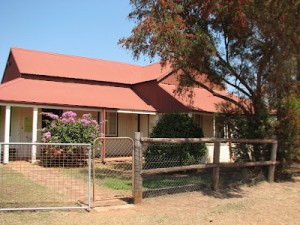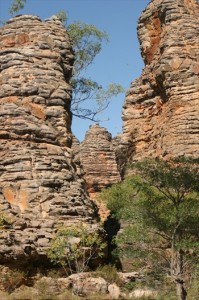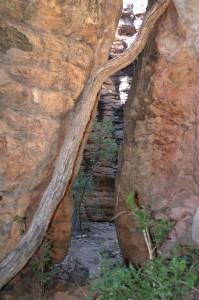While fishing is the main reason people come to King Ash Bay, the region has much more to offer.
Considered a lawless frontier town when first gazetted in 1885, Borroloola is now the commercial centre of the region and the ‘seat’ for the Roper Gulf Shire. The old police station was built in 1886. It remains in excellent condition and is listed on the National Estate under control of the National Trust. The building now houses a museum displaying the history of policing and other historical aspects of the region.
Short Video of the McArthur River Crossing at Borroloola.
Some information on the museum is available here:
https://sites.google.com/site/ntpmhsociety/our-rich-history/places/borroloola—historical
The aboriginal people of the region belong to four main tribal groups. The Yanyuwa and Marra are referred to as ‘saltwater people’ and are associated with the Sir Edward Pellew Islands and the lower reaches of the McArthur and Limmen Rivers. The Gundanji and Garrawa people are known as ‘mainland or freshwater people’ and are associated with land to the south and east of the present township of Borroloola. Gundanji lands include the site of the McArthur River Mine. Garrawa lands are near the Queensland border near Wollogorang Station and the Robinson River.
Borroloola draws it’s name from the aboriginal name of a nearby lagoon – Burrulula.
In recent years the McArthur River Mine, a zinc – lead mine owned by Xstrata Zinc has bought additional prosperity and employment to the area.
Carabirini Conservation Reserve
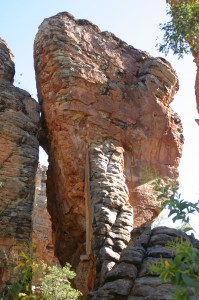 Caranbirini is located 46km south of Borroloola on the western edge of the Bukulara Range, just off the Carpentaria Highway (entrance is signposted on the Highway). It incorporates sandstone escarpments, a semi-permanent waterhole with surrounding riverine vegetation and areas of open woodland. The waterhole is surrounded by 25 metre high sandstone spires known as a ‘Lost City’. There are short walks that allow you to explore the area. Carabirini is easily accessible and is well worth a visit.
Caranbirini is located 46km south of Borroloola on the western edge of the Bukulara Range, just off the Carpentaria Highway (entrance is signposted on the Highway). It incorporates sandstone escarpments, a semi-permanent waterhole with surrounding riverine vegetation and areas of open woodland. The waterhole is surrounded by 25 metre high sandstone spires known as a ‘Lost City’. There are short walks that allow you to explore the area. Carabirini is easily accessible and is well worth a visit.
Waralungku Arts
Waralungku Arts is an Aboriginal owned and controlled arts centre located in Borroloola. It is an enterprise of Mabunji Aboriginal Resource Association Incorporated (Mabunji). Many of the artists have exhibited all over Australia in Darwin, Cairns, Sydney, Perth, Adelaide and Melbourne. In 2011 work from the centre was exhibited in London. For more information, see their web site.
http://www.waralungku.com
Barranyi (North Island) National Park.
Part of the Sir Edward Pellew group of islands, Barranyi (North Island) is the traditional home of the Yanyuwa Aboriginal people. The Park is Aboriginal freehold land and has been leased to the Northern Territory Government for management as a National Park. Due to the isolation and lack of feral predators the Park is an important refuge for fauna. The island’s beaches provide an important nesting site for four species of marine turtle as well as a resting point for many species of migratory bird.
Camping – is available at Paradise Bay and Mud Bay. Facilities are limited –
For further information, visit the NT Government website
http://www.nretas.nt.gov.au/national-parks-and-reserves/parks/find/barranyi
Poppy’s Pools
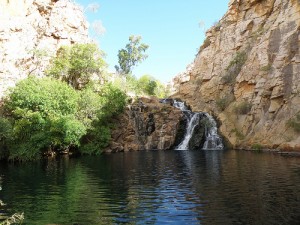 These thermal pools are situated 70 kilometers from Cape Crawford on Bauhinia Downs Station, traditional land of the Gundanji people. The hot spring water rises under pressure from a large aquifer system 5-7 km’s deep in the earths crust. It emerges to the surface through permeable faulted sandstone rock of the Roper Group, where it cools as it moves downstream and mixes with the water from the cool spring.
These thermal pools are situated 70 kilometers from Cape Crawford on Bauhinia Downs Station, traditional land of the Gundanji people. The hot spring water rises under pressure from a large aquifer system 5-7 km’s deep in the earths crust. It emerges to the surface through permeable faulted sandstone rock of the Roper Group, where it cools as it moves downstream and mixes with the water from the cool spring.
Access to the pools is by helicopter from Cape Crawford or by road. A permit is required and fees apply.

